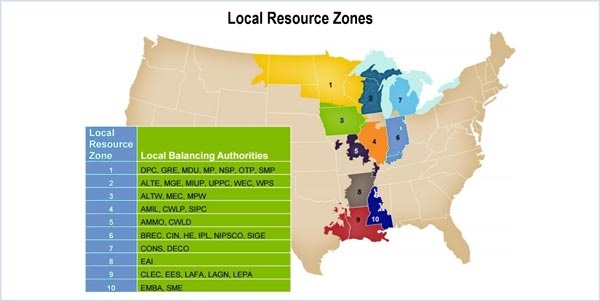By Amanda Durish Cook
MISO will have a 15.8% planning reserve margin for the 2017/18 planning year, up slightly from last year, according to the RTO’s loss-of-load-expectation study.
Jordan Cole, of MISO’s resource adequacy coordination group, told a Nov. 9 conference call of the Reliability Subcommittee that the reserve margin increased by 0.6% over last year’s 15.2%. MISO’s unforced capacity reserve margin is 7.8%, representing a 0.2% increase. In MISO, unforced capacity represents installed capacity minus forced outage rates. MISO’s systemwide installed capacity is at about 151 GW, while unforced capacity is at about 140 GW. The analysis predicts peak demand to hit 128 GW in early August 2017.
Cole said an increase in MISO’s forced outage rate and a forecasted reduction in load are driving the reserve margin increases. He added that local requirements have remained “mostly stable” from the 2016/17 planning year. MISO’s zonal installed capacity ranges from 23,642 MW in Michigan’s Zone 7 to 7,090 MW in Mississippi’s Zone 10.
Cole said MISO will return in the spring with results comparing the planning reserve margin to the planning reserve margin requirement, a value that’s calculated by factoring MISO systemwide load into the reserve margin; the requirement is yet to be announced.
Winter Seasonal Assessment All Clear
In the meantime, the MISO footprint should navigate the remainder of 2016 without major challenges, according to the RTO’s coordinated seasonal assessment, which did not identify any outstanding issues for the upcoming winter. Katherine Hulet, of MISO’s resource adequacy planning group, said the RTO does not predict any major constraints or thermal or voltage issues during the winter season. The assessment included studies of four MISO interfaces and six transfers. (See “Winter is Coming and Coordinated Seasonal Assessment is Scoped,” MISO Reliability Subcommittee Briefs.)
MISO predicts a 104-GW peak load this winter and expects to easily meet it with 142.9 GW of available supply. The RTO easily handled a mild October with a monthly peak at 90.4 GW on Oct. 17, said Steve Swan, senior manager of dispatch and balance.




